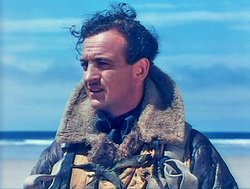A Matter of Life and Death
|
|

A Matter of Life and Death (1946) is a film by the British writer-director-producer team of Powell & Pressburger. The US title for the release was Stairway to Heaven, which was derived from the film's most prominent special effect: a broad marble escalator linking heaven and earth.
Story
The film stars David Niven as Peter Carter, a WW2 British bomber pilot forced to bail out over the English Channel without a parachute; Kim Hunter as June, the British-based American radio operator who talks to him in the few minutes before he jumps and with whom he later falls in love; Roger Livesey as Dr. Reeves, a doctor friend of June, who cares for and later pleads for the life of Carter before the celestial court; and Marius Goring as the unfortunate Conductor 71, who fails to catch Carter's soul as his body drops from the plane, and who therefore is responsible for Carter being alive beyond the date appointed for his death.
The film's action takes place on earth in Technicolor, and in heaven in black-and-white. In essence, Carter, who should have died, does not do so since Conductor 71 was unable to see him falling owing to the "English Fog" over the channel; Conductor 71, a Frenchman, is unimpressed. Carter lands on a sandbank, and is found by June who is cycling back from her nightshift; the pair fall in love. Conductor 71 appears, stopping time to discuss with Carter the reasonableness of Carter coming immediately to Heaven, since his time was up. Carter, in love, refuses and, inter alia, demands that the matter of his death be put to trial.
In Earthly time, meanwhile, Carter's visions of Conductor 71 are diagnosed by Doctor Reeves as arising from a brain injury sustained in the fall from the plane, and he is scheduled for surgery. The death of Reeves in a motorcycle accident makes him available in Heaven to plead his friend's case: which is that, through no fault of his own, Carter has fallen in love and now has an earthly commitment which should have precedence over Conductor 71's claim on Carter's soul.
The matter comes to a head before a celestial court of the whole population of heaven - in cinematographic terms, we zoom out from an amphitheatre to discover that the extent of its size is a spiral galaxy. Carter steps on to a mammoth moving stairway to Heaven as the trial takes place, whilst Reeves and Conductor 71 call witnesses from history to provide evidence for one side or the other.
Influence
The architecture of the film's Heaven is noticeably modernist; vast and open plan, with huge circular observation holes beneath which the clouds of Earth can be seen. This vision of Heaven was later the inspiration for the design of a bus station in Walsall, England, by architects Allford Hall Monaghan Morris, and the film's amphitheatre court scene was rendered by British Telecom in an TV advertisement in about 2002 as a metaphor for communication technology, especially the Internet.
The film garners praise, often couched in sentences including words such as "subversive" and "surreal".
In 2004 the magazine Total Film named A Matter of Life and Death the 2nd greatest British film ever made.
External links
- Template:Imdb title
- A Matter of Life and Death (http://www.screenonline.org.uk/film/id/438732/) at screenonline.org.uk
- Bus to Paradise (http://www.hughpearman.com/articles/bus.htm), a review of the AMOLAD Heaven inspired Walsall Bus Station.
- Reviews and articles (http://www.powell-pressburger.org/Reviews/46_AMOLAD) at the Powell & Pressburger Pages (http://www.powell-pressburger.org)
